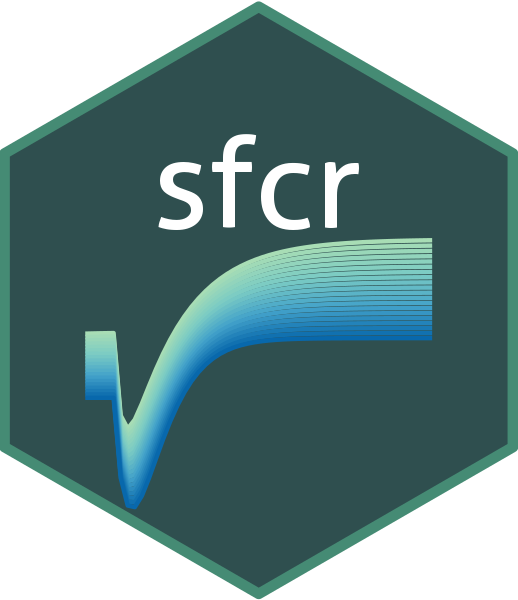The goal of the sfcr package is to provide an intuitive and tidy way
to estimate stock-flow consistent (SFC) models with R.
sfcr is on CRAN and can be installed with:
install.packages("sfcr")For the development version available on GitHub,
use the devtools package for installation:
# install.packages("devtools")
devtools::install_github("joaomacalos/sfcr")This is a basic example which shows how to simulate the “SIM” model from Godley and Lavoie (2007 ch. 3), as well as how to add scenarios to this baseline model.
The sfcr_set() function is used to create define the equations and
external variables of the model.
These sets are used to simulate the baseline scenario of the model with
the sfcr_baseline() function:
library(sfcr)
eqs <- sfcr_set(
TXs ~ TXd,
YD ~ W * Ns - TXs,
Cd ~ alpha1 * YD + alpha2 * Hh[-1],
Hh ~ YD - Cd + Hh[-1],
Ns ~ Nd,
Nd ~ Y / W,
Cs ~ Cd,
Gs ~ Gd,
Y ~ Cs + Gs,
TXd ~ theta * W * Ns,
Hs ~ Gd - TXd + Hs[-1]
)
external <- sfcr_set(
Gd ~ 20,
W ~ 1,
alpha1 ~ 0.6,
alpha2 ~ 0.4,
theta ~ 0.2
)
sim <- sfcr_baseline(
equations = eqs,
external = external,
periods = 60,
)
sim
#> # A tibble: 60 x 17
#> period TXs YD Cd Hh Ns Nd Cs
#> * <int> <dbl> <dbl> <dbl> <dbl> <dbl> <dbl> <dbl>
#> 1 1 1.00e-15 1.00e-15 1.00e-15 1.00e-15 1.00e-15 1.00e-15 1.00e-15
#> 2 2 7.69e+ 0 3.08e+ 1 1.85e+ 1 1.23e+ 1 3.85e+ 1 3.85e+ 1 1.85e+ 1
#> 3 3 9.59e+ 0 3.83e+ 1 2.79e+ 1 2.27e+ 1 4.79e+ 1 4.79e+ 1 2.79e+ 1
#> 4 4 1.12e+ 1 4.48e+ 1 3.59e+ 1 3.15e+ 1 5.59e+ 1 5.59e+ 1 3.59e+ 1
#> 5 5 1.25e+ 1 5.02e+ 1 4.27e+ 1 3.90e+ 1 6.27e+ 1 6.27e+ 1 4.27e+ 1
#> 6 6 1.37e+ 1 5.48e+ 1 4.85e+ 1 4.53e+ 1 6.85e+ 1 6.85e+ 1 4.85e+ 1
#> 7 7 1.47e+ 1 5.86e+ 1 5.33e+ 1 5.06e+ 1 7.33e+ 1 7.33e+ 1 5.33e+ 1
#> 8 8 1.55e+ 1 6.19e+ 1 5.74e+ 1 5.52e+ 1 7.74e+ 1 7.74e+ 1 5.74e+ 1
#> 9 9 1.62e+ 1 6.47e+ 1 6.09e+ 1 5.90e+ 1 8.09e+ 1 8.09e+ 1 6.09e+ 1
#> 10 10 1.68e+ 1 6.71e+ 1 6.38e+ 1 6.22e+ 1 8.38e+ 1 8.38e+ 1 6.38e+ 1
#> # ... with 50 more rows, and 9 more variables: Gs <dbl>, Y <dbl>, TXd <dbl>,
#> # Hs <dbl>, Gd <dbl>, W <dbl>, alpha1 <dbl>, alpha2 <dbl>, theta <dbl>With the steady state values at hand, we can use the sfcr_scenario()
function to see what happens if we increase government expenditures Gd
from 20 to 30:
shock <- sfcr_shock(
variables = sfcr_set(
Gd ~ 30
),
start = 5,
end = 60
)
sim2 <- sfcr_scenario(
baseline = sim,
scenario = shock,
periods = 60
)
sim2
#> # A tibble: 60 x 17
#> period TXs YD Cd Hh Ns Nd Cs Gs Y TXd Hs
#> * <int> <dbl> <dbl> <dbl> <dbl> <dbl> <dbl> <dbl> <dbl> <dbl> <dbl> <dbl>
#> 1 1 20.0 80.0 80.0 80.0 100. 100. 80.0 20 100. 20.0 80.0
#> 2 2 20.0 80.0 80.0 80.0 100. 100. 80.0 20 100. 20.0 80.0
#> 3 3 20.0 80.0 80.0 80.0 100. 100. 80.0 20 100. 20.0 80.0
#> 4 4 20.0 80.0 80.0 80.0 100. 100. 80.0 20 100. 20.0 80.0
#> 5 5 23.8 95.4 89.2 86.2 119. 119. 89.2 30 119. 23.8 86.2
#> 6 6 24.8 99.2 94.0 91.4 124. 124. 94.0 30 124. 24.8 91.4
#> 7 7 25.6 102. 98.0 95.8 128. 128. 98.0 30 128. 25.6 95.8
#> 8 8 26.3 105. 101. 99.5 131. 131. 101. 30 131. 26.3 99.5
#> 9 9 26.8 107. 104. 103. 134. 134. 104. 30 134. 26.8 103.
#> 10 10 27.3 109. 107. 105. 137. 137. 107. 30 137. 27.3 105.
#> # ... with 50 more rows, and 5 more variables: Gd <dbl>, W <dbl>, alpha1 <dbl>,
#> # alpha2 <dbl>, theta <dbl>With sfcr, the models are written entirely within R and use the
standard R syntax. Furthermore, their output is a tibble, meaning that
it can be easily manipulated with dplyr and other tidyverse tools
and plotted with ggplot2.
Check the notebooks that replicate the models in Godley and Lavoie (2007) for more detailed examples on the usage of the package.
I’m grateful to Severin Reissl for his very useful comments and for always pointing me in the right direction, to Marc Lavoie for answering all my questions about SFC modeling, and to Italo Pedrosa for our discussions about the state of the SFC field.
I’d also like to acknowledge all the developers and academics that share
their code and make the SFC field alive. In particular, many thanks to
Antoine Godin for answering all my queries about the PKSFC
package, from which I draw much
inspiration, specially in the DAGs section of the package, to Gabriel
Petrini da Silveira and Kenn Takara for their pysolve3
package, from which I found the
references to implement the Broyden solver in R, and to Gennaro Zezza
for his invaluable
macros to simulate
the models in Godley and Lavoie (2007).
Godley, Wynne, and Marc Lavoie. 2007. Monetary Economics: An Integrated Approach to Credit, Money, Income, Production and Wealth. Palgrave Macmillan.
